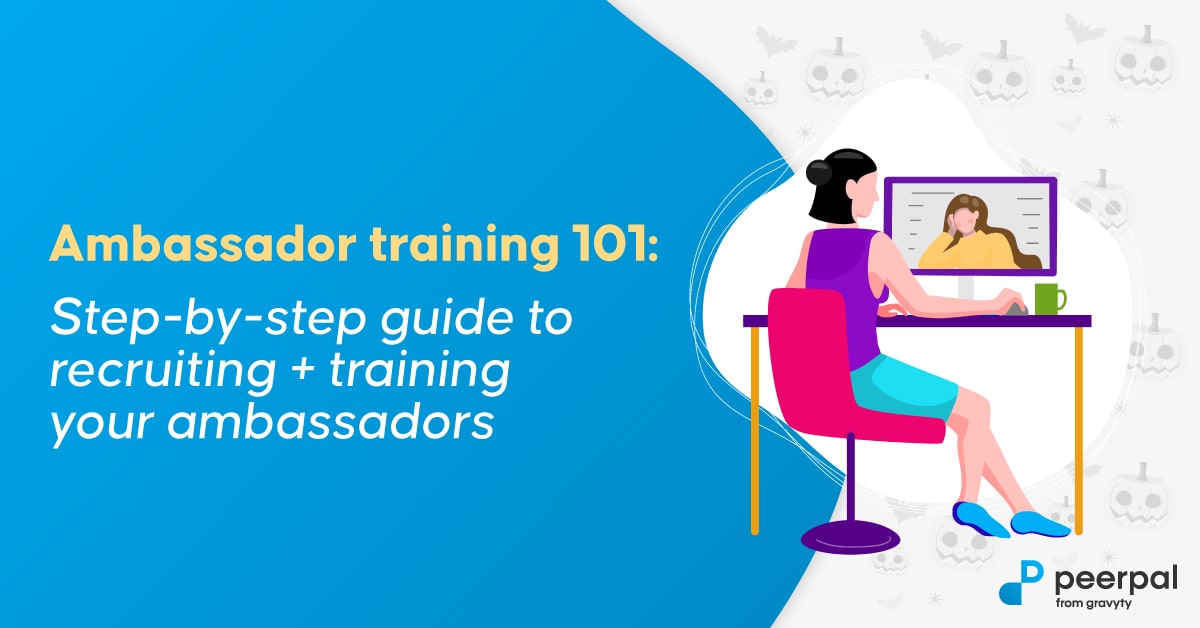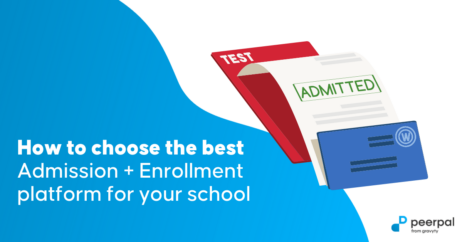Ambassador training 101

Step-by-step guide to recruiting + training your ambassadors
Your admissions partners
This 3-part toolkit is a practical guide to starting an ambassador program at your school. It was built in response to requests from busy admissions professionals looking for a helping hand in getting their own ambassador programs off the ground.
At Gravyty, we knew exactly who could help: admissions professionals we work with on our PeerPal from Gravyty platform. To create this toolkit, we interviewed admissions professionals with standout ambassador programs: Shady Side Academy, Montcrest School, Oakwood School, and Eastern Christian School. We coupled their insight with the thought leadership of our own staff with deep admissions experience.
Recruiting ambassadors
Recruitment is the first step in creating your parent and student ambassador program.
1. Connect with active parents directly
Parents that are already active, such as class parents, athletic boosters, and active members of the Parent Association are often the same parents who would want to help the school as ambassadors. Reach out to those active parents directly and present your plan at the next Parent Association meeting.
2. Advertise and post openly within the school community
Create a short, clear message expressing that you are recruiting virtual admission ambassadors. Add a graphic and post on your school’s social media sites, newsletter, and more. Include a contact email for questions.
If you already use the PeerPal from Gravyty, you can invite potential ambassadors individually or in bulk directly from your platform. Invitees will receive a personalized email with links to watch a video tutorial and officially sign-up as an ambassador. Profiles are only visible after the platform admin approves them.
3. Keep an eye on diversity
Diverse hands make diverse audiences more comfortable.
Rudi Gesch, Eastern Christian School
Rudi Gesch, Director of Marketing and Enrollment at Eastern Christian, has grown his ambassador program with PeerPal from Gravyty from 6-8 per year to a current 17 ambassadors.
However, even when he started small, he recognized the value of diversity in his ambassadors so that as many prospective families as possible would have an ambassador with whom they could easily connect. Gesch stresses the importance of having parents and guardians serve as ambassadors and people of varied ethnic and language backgrounds in the role.
4. Share a list of responsibilities and expected time commitment
Many potential ambassadors will want more information before they sign up. Prepare a template with a list of responsibilities and expected time commitments that you can send with each inquiry.
Want a sample email to parents? Get the toolkit!
5. Start looking for ambassadors—before you need ambassadors
If you’re reading this and you don’t have an ambassador program yet, now’s the time to start. Although it’s possible to succeed with a short turnaround, it’s ideal to give your new virtual ambassadors time to ask questions, and yourself time to look at events on the school calendar and prepare to present the ambassador program to captive audiences. If you don’t yet have your PeerPal from Gravyty platform, keep track of interested ambassadors with a Google Form questionnaire.
6. Be flexible
Ambassadors may or may not be available year-round. Don’t turn away an ambassador that can only help
welcome accepted families in the spring or is nervous about the time commitment. There are many ways to include these types of ambassadors.
For instance, certain ambassadors can have their profiles invisible, activated only for proactive outreach. In addition, ambassadors can activate their vacation mode anytime they need a break.
Training parent + student ambassadors
1. Hold an ambassador training session
This session can be in person or online, and should be recorded so it can be sent to the ambassadors unable to attend. It should include the topics listed below and can also include the short PeerPal from Gravyty training video, made especially for ambassadors.
This is also an opportunity to generate excitement and show your ambassadors how much you appreciate their help!
2. Share the bigger picture
For best success, make your ambassadors feel a part of the admissions team. One important step is to give them an overview of the admissions process and timeline at your school. Even though they are not responsible for sharing deadline information, it helps them understand the big picture in which they play an integral role.
This also helps connect to the different stages of prospective family they encounter—from initial inquiries to parents who have attended admissions events to accepted families whom the school wants to encourage to enroll.
3. Define expectations as an ambassador
- Introduce yourself—Although questions sent may get right to the point, encourage the ambassador to work in an introduction about themselves and their students into the answer.
- Be authentic—Anyone who is a school ambassador should have the baseline of being happy with the school and wanting to contribute to its success. Therefore, you want to empower your parents to communicate with authenticity. Don’t give them prepackaged answers. And if, occasionally, a negative is mentioned along with a lot of positive, it only adds to the believability and, ultimately, value of the ambassador interaction.
- Be responsive—Ambassadors will get an email notification whenever they have a new message. Try to answer as soon as possible, and within 48 hours at the most. If an ambassador is going to be away or is particularly busy, they should turn on the vacation mode on their profile.
- Know when to be an expert—and when to pass to someone else. The ambassador can answer with insight on many questions, but some should be passed to the admissions department. Clarify which types of questions should be passed on. Usually, the questions that should go to staff involve financial aid, technical help with application software, or statistics about the school.
4. Storytelling as a form of recruitment
Encourage ambassadors to answer questions with a story from their own experiences. Storytelling helps the prospective family better imagine themselves as part of the school.
5. Review commonly asked questions
Help your ambassadors feel prepared by sharing a list of commonly asked questions about details with which they may or may not feel confident replying.
6. Prepare for sensitive topics
Share with your ambassadors strategies to deal with sensitive topics such as discrimination, micro-aggressions, bullying and more.
Remind your student ambassadors that you are available to support or they can pass questions on to you. If authentic, it’s also okay to tell a prospective family that you do not have experience in that topic.
1. Request regular feedback
The ambassador program feeds itself once you give the parents ownership. Ask the parents for collaboration on resolving issues.
Natalie Hollinshead, Director of Admissions, Montcrest School
Natalie Hollinshead, Director of Admissions at Montcrest School, says communication with parent ambassadors is a key to her school’s rich and active ambassador program’s success. As you begin your program, you can utilize short surveys to hone the program.
Start by surveying ambassadors at three points during the first year: after training, mid-year and end of year. Returning ambassadors may be asked for feedback mid-year and end of year—or more often if you prefer.
After training
- What was most helpful about the training?
- Do you have any concerns as a new ambassador?
- What should be covered in next year’s training that wasn’t covered this year?
- Would you like a copy of the PeerPal training video to review using the platform?
Mid-year
- Has your time commitment as an ambassador been lower or higher than you expected?
- What support do you feel that you need from the admissions team or the school?
- How can we improve the ambassador program?
- Do you feel confident sending out welcome messages to accepted students, or would you like to receive a short training video?
- Rate your experience as a parent ambassador on a scale of 1 (low) to 10 (high).
End of year
- What is a the strength of the ambassador program?
- What is something that should be improved for next year?
- What should be covered in next year’s training that wasn’t covered this year?
- What was your weekly time commitment? Did it vary throughout the year?
- How well did the ambassador program meet your expectations?
- What are the two questions you received most frequently?
- Did you participate in outreach this year? If so, was it a positive experience?
- What’s the most important thing a new ambassador should know?
- Rate your experience as a parent ambassador on a scale of 1 (low) to 10 (high).
- Will you join us again next year as an ambassador?
2. Recruit new ambassadors more than once a year
Regular recruitment calls will help keep your team full. In addition, vary recruiting to include in-person events such as a fall open house, and digital opportunities such as a school newsletter or social media account, as well as virtual open houses.
3. Avoid burnout
Be flexible with time commitments. Some ambassadors may express that they have interest and capacity for more hours, while others have very few spare moments.
Encourage the use of vacation mode on the PeerPal from Gravyty platform to moderate time commitments for busy parents.
4. Play to the strengths (and areas of enjoyment) of ambassadors
When possible, match ambassadors with prospects or accepted families with shared interests. Learn which ambassadors prefer to field questions and which like to record welcome videos.
5. Celebrate success and show gratitude
Share “wins” such as positive feedback from prospective and accepted families or admissions statistics.
Take opportunities to thank your ambassadors, both personally and on school-wide platforms. Gift your ambassadors with tokens of appreciation such as school spirit items or an end-of-the-year breakfast.
Interested in mobilizing your passionate community of parent, staff and student ambassadors to elevate admissions and enrollment and increase yield? Let’s talk.




